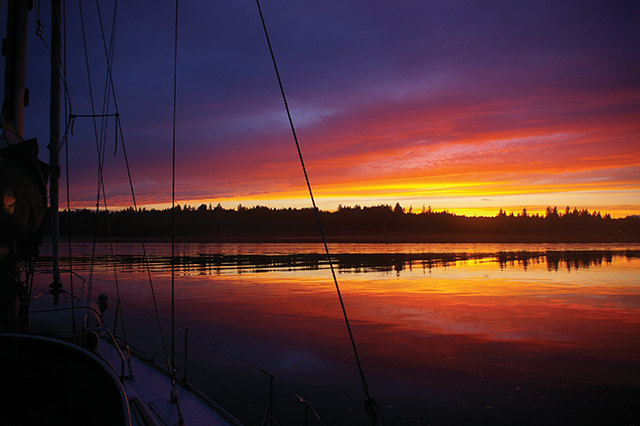(published December 2013)
The Caribbean, the South Pacific, the Mediterranean, the East or West Coast of the U.S. and Canada, Southeast Asia, Northern Europe and more—how can a well-traveled cruiser choose their favorite?
Any cruising sailor with a fair amount of miles under their keel will get asked the question, “What is your favorite cruising destination?” Of course, this is nearly impossible to answer, but we thought it would be fun to put it to some of our regular contributors and editors who have traveled the world’s oceans and visited many of the world’s best cruising locales.
DANIEL COLLINS—Nova Scotia
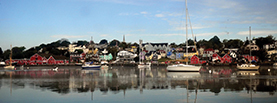
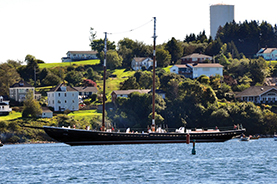
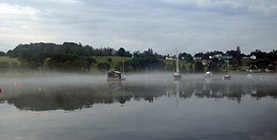 I’m a huge fan of the Canadian Maritimes, particularly the Atlantic coast regions of Nova Scotia where I’ve sailed the most. Among my favorite areas are the gorgeous St. Margaret’s Bay and Mahone Bay. The towns along them are delightful and offer a blend of remote islands and coves with quaint seaside harbors and villages. The idyllic town of Lunenburg is a must-see, with its brightly colored buildings, many of which are over 100 years old, and its collection of offshore fishing boats and classic schooners. Home to several tall ships including the Bluenose II, Lunenburg has a special history behind its waterfront.
I’m a huge fan of the Canadian Maritimes, particularly the Atlantic coast regions of Nova Scotia where I’ve sailed the most. Among my favorite areas are the gorgeous St. Margaret’s Bay and Mahone Bay. The towns along them are delightful and offer a blend of remote islands and coves with quaint seaside harbors and villages. The idyllic town of Lunenburg is a must-see, with its brightly colored buildings, many of which are over 100 years old, and its collection of offshore fishing boats and classic schooners. Home to several tall ships including the Bluenose II, Lunenburg has a special history behind its waterfront.

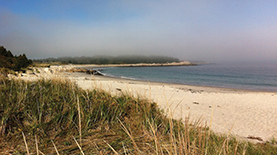 And if you need a city fix, Halifax has an excellent and relatively affordable waterfront, all the amenities you could ask for, and some great “nooks and crannies” to anchor in, including the Northwestern Arm. The entire coastline of Nova Scotia is beautiful and rugged, with dramatic bays and occasionally dramatic weather. Also, the people are friendly and there is a great camaraderie among the sailing community. Don’t miss the rest of the Atlantic Maritimes either, as Prince Edward Island, the Magdalens, and Newfoundland offer even more stunning coastlines and remote anchorages. And if you’re truly brave, you can head to Labrador and enjoy the sea ice and polar winds. I’ll stick to Nova Scotia, though!
And if you need a city fix, Halifax has an excellent and relatively affordable waterfront, all the amenities you could ask for, and some great “nooks and crannies” to anchor in, including the Northwestern Arm. The entire coastline of Nova Scotia is beautiful and rugged, with dramatic bays and occasionally dramatic weather. Also, the people are friendly and there is a great camaraderie among the sailing community. Don’t miss the rest of the Atlantic Maritimes either, as Prince Edward Island, the Magdalens, and Newfoundland offer even more stunning coastlines and remote anchorages. And if you’re truly brave, you can head to Labrador and enjoy the sea ice and polar winds. I’ll stick to Nova Scotia, though!
ANDREW CROSS—San Juan Islands & Puget Sound
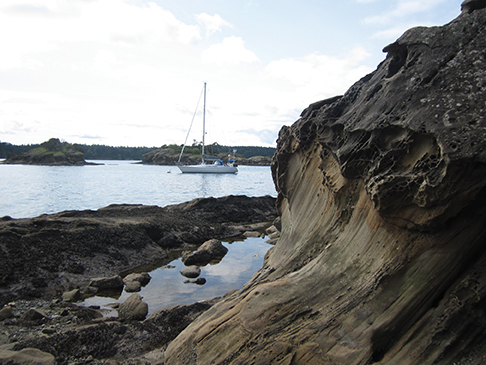 Anchored next to a small island covered in old growth forest a giant bald eagle soared overhead looking for dinner. Ours was cooking on the grill as we sat in the cockpit admiring the evening sun’s glow on Mount Rainier’s glaciers in the distance. This is life cruising the Puget Sound and San Juan Islands.
Anchored next to a small island covered in old growth forest a giant bald eagle soared overhead looking for dinner. Ours was cooking on the grill as we sat in the cockpit admiring the evening sun’s glow on Mount Rainier’s glaciers in the distance. This is life cruising the Puget Sound and San Juan Islands.
When considering the “Favorite Cruising Destination” dilemma it would have been easy to choose the B.V.I. or any number of tropical locales. But I’m tipping my cap to a place Jill and I have recently come to love: Washington State’s San Juan Islands and Puget Sound.
Over the past year and a half we’ve explored this expansive north-south corridor of beautiful sailing and scenery from Sucia Island on the northern edge of the San Juan Islands all the way to Olympia in the south Puget Sound. Throughout this cruising area there are over 40 Marine State Parks with anchorages, moorings, docks and plenty of hiking to keep your legs busy. Also, quaint maritime villages, towns and cities pepper the islands and sound including Gig Harbor, Port Townsend, Seattle, Poulsbo, Friday Harbor and many more.
The San Juan Islands are—rightfully so—the cruising gem of the area, but this also makes them quite crowded in the summer which is why we choose to visit in the offseason when anchorages and hiking trails are empty. For summer cruising, we followed a tip from fellow cruisers who said heading south would provide fewer boats, underexplored scenery and warmer, swimmable water. We weren’t disappointed. When not heading north or south we don’t need to venture too far from the middle of the sound. There are numerous anchorages, islands and towns near Seattle to fill a weekend or week of cruising.
Another unique aspect of cruising this area is the stunning views you get of the Olympic Mountains to the west and Cascade Mountains to the east. They don’t have to just be views, though, as the mountains are relatively close. If you want to get off the boat for a day or two, a bus or car ride from a few key ports can put you in a highland paradise in an hour or two.
GEORGE DAY—Warderick Wells Exumas, Bahamas
 Rosie and I with our two sons Simon and Tim have cruised all over the world and have been lucky enough to complete a five-year circumnavigation aboard our old Mason 43 Clover. Many destinations far and wide stand out in our memories, yet one close to home is forever going to be our first foreign and favorite cruising ground.
Rosie and I with our two sons Simon and Tim have cruised all over the world and have been lucky enough to complete a five-year circumnavigation aboard our old Mason 43 Clover. Many destinations far and wide stand out in our memories, yet one close to home is forever going to be our first foreign and favorite cruising ground.
The Exuma chain in the Bahamas is a string of hundreds of cays and islands that run from New Providence all the way south to the southern edge of the Bahama Bank. The islands lie on the edge of the bank and front the deep water of Exuma Sound, so you can cruise along the western side in the shallows of the bank or make long quick runs in deep water in the more exposed eastern side of the chain.
For most cruisers, Georgetown and Elizabeth Harbor inside Lee Stocking Island are the destinations for a winter’s cruise of the Exumas. By February you will find up to 400 cruising boats anchored in this idyllic spot where the waters are clear, the anchorages secure and the white beaches strewn with sand dollars.
But halfway down the island chain, you will find our favorite Exuma destination at Warderick Wells. The island has secure mooring fields on the north and south sides and offers some of the best diving in all of the Bahamas. Home to the Exuma Cays Land and Sea Park, Warderick Wells and the hundreds of little cays around it are all protected from fishing, lobstering and bird hunting. That means the birds are nearly tame and will land on your deck or a picnic table ashore to check out what you are eating. And, under the water giant grouper or spotted eagle rays will swim by unafraid and curious.
On our voyage around the world, it was at Warderick Wells that we first stopped to while away a week of swimming, hiking and getting into the cruising state of mind. And it’s less than 200 miles from Miami. Last winter, we took our Jeanneau 45.2 Lime’n to the Exumas for the winter and once again we made Warderick Wells our main base in the islands.
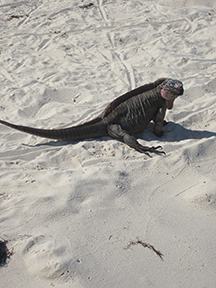 We joined the Bahamas National Trust and became friends of the ECLSP. Our $25 donation was a small token of support for the trust but it gave us first pick each morning of the moorings inside the park. That’s a good thing, too, since Warderick Wells is one of the most protected anchorages and mooring fields in the Exumas.
We joined the Bahamas National Trust and became friends of the ECLSP. Our $25 donation was a small token of support for the trust but it gave us first pick each morning of the moorings inside the park. That’s a good thing, too, since Warderick Wells is one of the most protected anchorages and mooring fields in the Exumas.
When we think of special destinations that we will always return to, Warderick Wells in the Exumas is at the top of the list.
ELLEN MASSEY LEONARD—Society Islands, French Polynesia
It’s the second most common question people ask me, right after “Did you encounter any storms?” But it’s harder to answer than the storm question. I have so many favorite places. Each new landfall promises new people, new sights and new experiences. A few ports have felt even more special because of the difficulty of the passages preceding them. And some were simply beautiful, like French Polynesia’s Society Islands.
The Societies are best known for Tahiti and Bora Bora. Reefs rising many meters from the sea floor fringe these hilly, volcanic isles, and between reef and island lie coral-studded lagoons. Motus, islets covered with coconut palms, have formed atop some of the fringing reefs. Provided one has a good chart and a sharp lookout at the bow, the lagoons offer protected anchorages undisturbed by the ocean swell. The strong, consistent trade winds make for exhilarating sails between the islands. Ashore one meets with Polynesian dancing, farmer’s markets and even restaurants. The only major drawback is the cost of visiting. On top of extremely expensive goods and services, non-European Union sailors must post a bond upon entry, about the price of an airline ticket to their country of origin, and one is bound to lose money in fees and exchange rates. But with planning and preparation—for both the bond and provisions—French Polynesia is worth every penny.
For me, the Societies combined the best of two worlds: lush mountains to hike and coral reefs on which to scuba dive. I could climb past banyan trees, ancient stone platforms called marae, and gardenia-like frangipani. I could take in views of the pale blue lagoon below me, the white surf pounding the barrier reef and the pelagic blue ocean beyond. That same afternoon, I could be 80 feet beneath the sea among lemon sharks, manta rays and rainbow parrotfish. Then in the evening, I’d join my fellow sailors on the beach to watch for a green flash as the sun set into the sea. Good friends, a safe anchorage, teeming reefs, beautiful hikes, great sailing and a fascinating local culture: Although I encountered many more places that captivated me in different ways, none combined so many of my interests as well as the Societies.
JOHN NEAL—Svalbard, My favorite cruising destination
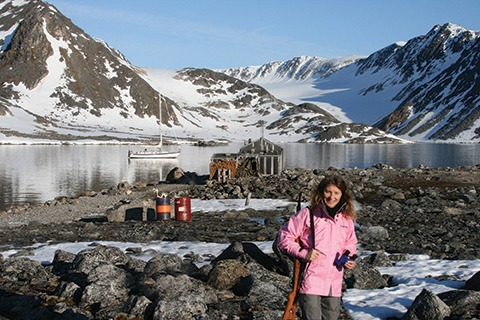 Tropical cruising is seductive: sailing in the trade winds, snorkeling in crystal-clear bathwater temperature lagoons, meeting fascinating islanders of very unusual cultures. But it’s the challenge of high-latitude cruising that has me excited about our five year round trip expedition voyage from New Zealand to Svalbard with my wife Amanda Swan Neal. We will depart Auckland in May 2014, sailing to Scandinavia via Alaska and the Panama Canal culminating in sailing to the edge of the ice pack, 550 miles from the North Pole in June 2016.
Tropical cruising is seductive: sailing in the trade winds, snorkeling in crystal-clear bathwater temperature lagoons, meeting fascinating islanders of very unusual cultures. But it’s the challenge of high-latitude cruising that has me excited about our five year round trip expedition voyage from New Zealand to Svalbard with my wife Amanda Swan Neal. We will depart Auckland in May 2014, sailing to Scandinavia via Alaska and the Panama Canal culminating in sailing to the edge of the ice pack, 550 miles from the North Pole in June 2016.
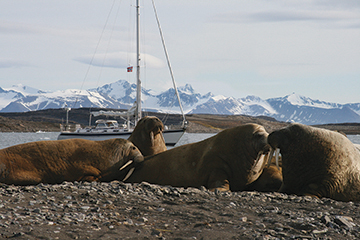 The attractions of Svalbard are many, but high on the list are the few months of 24 hour per day intense sunlight and the incredible array of wildlife from polar bears, walrus and whales to the inquisitive endemic reindeer and frisky artic fox kits. The rugged and harsh beauty of the island landscape is tamed by pockets of wild flowers and nesting birds but tensioned by the constant threat of polar bear attacks, requiring that we always carry a rifle for protection when ashore. Weather monitoring is a high priority, realizing a change of wind direction and velocity can bring ice into many of the anchorages, making them death traps. When we were here in 2001 we were briefly beset (trapped) in wind-blown ice pack and in 2007 we spent several hours aground on a mischarted rock that we discovered at six knots.
The attractions of Svalbard are many, but high on the list are the few months of 24 hour per day intense sunlight and the incredible array of wildlife from polar bears, walrus and whales to the inquisitive endemic reindeer and frisky artic fox kits. The rugged and harsh beauty of the island landscape is tamed by pockets of wild flowers and nesting birds but tensioned by the constant threat of polar bear attacks, requiring that we always carry a rifle for protection when ashore. Weather monitoring is a high priority, realizing a change of wind direction and velocity can bring ice into many of the anchorages, making them death traps. When we were here in 2001 we were briefly beset (trapped) in wind-blown ice pack and in 2007 we spent several hours aground on a mischarted rock that we discovered at six knots.
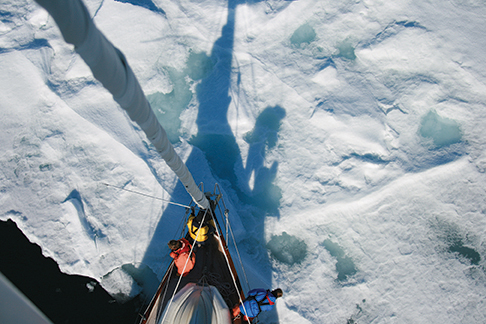 Spitsbergen, the main island in the Svalbard archipelago is located 500 miles north of Norway and Russia and 620 miles south of the North Pole, has been visited by Russian and Norwegian whalers and trappers since the 15th and 16th centuries. It has been the site of coal mining since the late 19th century and Russia and Norway still operate coalmines there today. Norway’s main settlement of Longyearbyen has a university town meets wild west feeling while Russia’s active coal mining settlement of Barentsburg is reminiscent of its communist past. Elsewhere on Spitsbergen a few international scientific stations are scattered in the western fjords and old trapper’s huts, abandoned expedition bases and whaling stations provide interesting exploration.
Spitsbergen, the main island in the Svalbard archipelago is located 500 miles north of Norway and Russia and 620 miles south of the North Pole, has been visited by Russian and Norwegian whalers and trappers since the 15th and 16th centuries. It has been the site of coal mining since the late 19th century and Russia and Norway still operate coalmines there today. Norway’s main settlement of Longyearbyen has a university town meets wild west feeling while Russia’s active coal mining settlement of Barentsburg is reminiscent of its communist past. Elsewhere on Spitsbergen a few international scientific stations are scattered in the western fjords and old trapper’s huts, abandoned expedition bases and whaling stations provide interesting exploration.
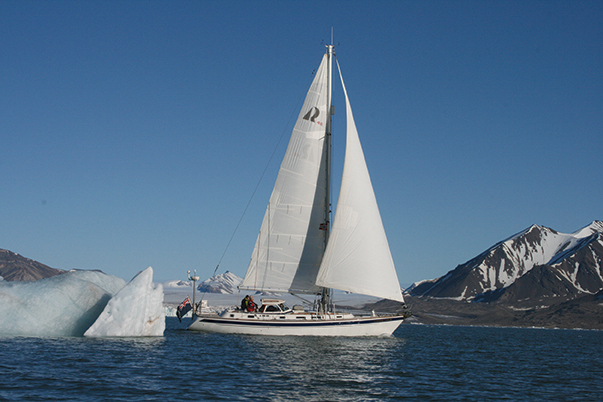 John Neal’s 322,000 miles and 39 years of cruising include many high latitude and tropical destinations. For details about joining John and Amanda on their next 2016 Spitsbergen expedition, visit www.mahina.com.
John Neal’s 322,000 miles and 39 years of cruising include many high latitude and tropical destinations. For details about joining John and Amanda on their next 2016 Spitsbergen expedition, visit www.mahina.com.
NADINE SLAVINSKI—Panama’s Forgotten Pearls
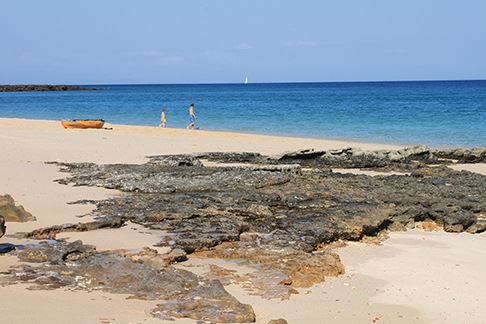 Choosing a favorite cruising ground is like choosing a favorite child. Impossible! So we’ll throw a dart and take the first of many magical Pacific destinations as a case study. The archipelago of Las Perlas lie just a day sail from Panama City, but are a world apart in every way: blue water sailing meets coastal convenience. Largely uninhabited and inexplicably ignored by the cruising fleet, Las Perlas are a sailor’s wonderland—a place to get away from cruising and city crowds. The water teems with life thanks to rich ocean currents that nourish the entire food chain, from tiny krill to breaching whales. In this way, Las Perlas resembled our next Pacific destination, the Galapagos Islands.
Choosing a favorite cruising ground is like choosing a favorite child. Impossible! So we’ll throw a dart and take the first of many magical Pacific destinations as a case study. The archipelago of Las Perlas lie just a day sail from Panama City, but are a world apart in every way: blue water sailing meets coastal convenience. Largely uninhabited and inexplicably ignored by the cruising fleet, Las Perlas are a sailor’s wonderland—a place to get away from cruising and city crowds. The water teems with life thanks to rich ocean currents that nourish the entire food chain, from tiny krill to breaching whales. In this way, Las Perlas resembled our next Pacific destination, the Galapagos Islands.
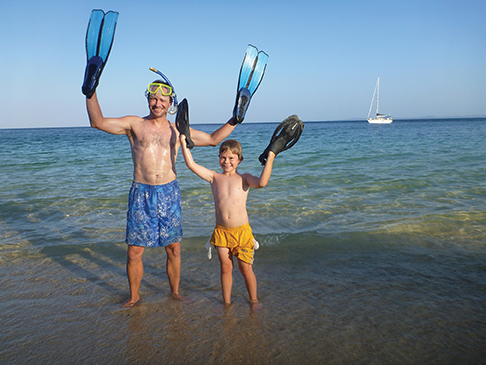 In fact, many of the highlights of our subsequent Pacific crossing were foreshadowed in Las Perlas. The Marquesas exude mystery, like the secrets hidden behind every corner in Las Perlas. The struggle to narrow the choices among the many islets of Las Perlas was a taste of things to come in the scattered atolls of the Tuamotus. Thousands of miles west, Tonga was to be a place of feasts, just as Las Perlas offered a feast for the senses: the scratch of hermit crabs scuttling across the sand on Isla Chapera, the splash of pelicans diving on Isla Viveros, the calls of songbirds hidden in the trees.
In fact, many of the highlights of our subsequent Pacific crossing were foreshadowed in Las Perlas. The Marquesas exude mystery, like the secrets hidden behind every corner in Las Perlas. The struggle to narrow the choices among the many islets of Las Perlas was a taste of things to come in the scattered atolls of the Tuamotus. Thousands of miles west, Tonga was to be a place of feasts, just as Las Perlas offered a feast for the senses: the scratch of hermit crabs scuttling across the sand on Isla Chapera, the splash of pelicans diving on Isla Viveros, the calls of songbirds hidden in the trees.
Las Perlas’ serene days, refreshingly cool water, and balmy evenings are an antidote to city nerves. By night, the constellations wink madly above, encouraging hardy sailors on. “You can do it,” they whisper. The equator lies just over there, and boundless island treasures lie beyond. In a way, we previewed much of the South Pacific in Las Perlas. Come and see for yourself, but don’t stop there!

















